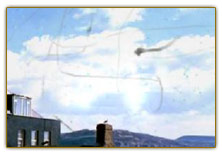Flashes & Floaters
It is very common for people to see tiny floaters from time to time. They become evident when you look at a uniform surface, especially white or blue (for example while looking at the sky). These common and occasionally seen floaters are of no concern. The eye is hollow like an egg. Within the hallow center of the eye is a gel called the vitreous. The vitreous is analogous to the white of an egg. Just like all gels, the solid component of the gel can form areas of coagulation. These small areas of more solid vitreous float in the gel and are what causes the occasional floater to be noticed. In addition, you can actually occasionally perceive blood cells flowing through the tiny vessels of the retina which can also result in the floaters you see. This is called an entoptic phenomenon.
 A key warning sign of potential trouble is when you see a sudden onset of floaters. This is even more concerning when the sudden onset of floaters is dramatic and associated with hundreds and hundreds of floaters (a “shower of floaters”) as if someone was shaking a pepper shaker in front of your eyes. Other significant warning signs of trouble include associated flashes of light and/or loss of peripheral (side) vision. Most often a sudden onset of floaters results in seeing only one or a few floaters. Typically they appear like a “cob-web” or “spider-like”. This type of experience may be associated with some flashes of light for the first day or so only, but typically not associated with peripheral vision loss or hundreds of floaters. This very common condition is called Posterior Vitreous Detachment (PVD).
A key warning sign of potential trouble is when you see a sudden onset of floaters. This is even more concerning when the sudden onset of floaters is dramatic and associated with hundreds and hundreds of floaters (a “shower of floaters”) as if someone was shaking a pepper shaker in front of your eyes. Other significant warning signs of trouble include associated flashes of light and/or loss of peripheral (side) vision. Most often a sudden onset of floaters results in seeing only one or a few floaters. Typically they appear like a “cob-web” or “spider-like”. This type of experience may be associated with some flashes of light for the first day or so only, but typically not associated with peripheral vision loss or hundreds of floaters. This very common condition is called Posterior Vitreous Detachment (PVD).
This is a condition when the more solid portion of the vitreous separates from the watery or “aqueous” portion of the vitreous. PVD’s are usually very frightening to patients when they occur due to a fear of retinal detachment. Fortunately the vast majority of PVD’s are benign and become less bothersome (in terms of noticing the floaters) over time. Virtually all persons will eventually have PVD. Not everyone perceives the symptoms of PVD, but it occurs with greater frequency with advancing age. It occurs at earlier ages in nearsighted (myopic) patients and with blunt eye trauma as well. Unfortunately a small percentage of PVD’s are associated with retinal tears (less than 1%). There can be traction on the retina as the more solid vitreous moves forward with PVD. This traction may result in a break in the retinal surface. The danger of a retinal tear is that fluid from the vitreous can seep under the tear and cause aretinal detachment, which is a very serious condition. It is very difficult to differentiate a PVD without break from a PVD with retinal break without performing an extensive examination of the vitreous and retina.
